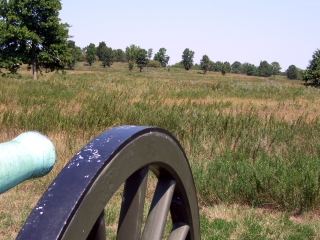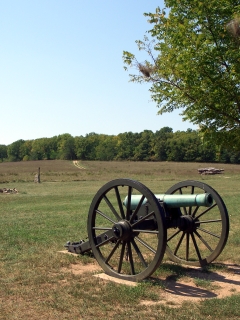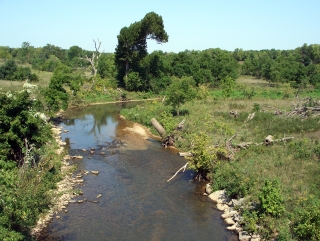NPS Website; Local Website
 WHAT IS IT?
WHAT IS IT?Site of an August 10, 1861 battle, the first major Civil War fight west of the Mississippi River.
BEAUTY (3/10)
The Battlefield is located on an anonymous southwestern Missouri field, about 10 miles from downtown Springfield. A shallow, slow-moving creek meanders its way though the overgrown fields, hillsides and orchards. The Park’s 5-mile auto tour-loop road is self-contained and inaccessible to through traffic. There are no stone monuments marking fallen officers and fierce fighting. The Battlefield has changed little since 1861. The grounds are preserved and protected, but are they beautiful? Not one bit.
HISTORICAL INTEREST (6/10)
Missouri. Oh, Missouri. During the Civil War, from 1861-65, no state was more compelling, more vexing, more fascinating or more insane. To historians and Civil War buffs, Missouri was almost like the United States in miniature, except it does not have that helpful Mason-Dixon Line. Pro-Union (as in the Army), pro-Confederacy, pro-union (small u, as in the country’s unity), anti-union, pro-slavery and anti-slavery interests mixed and matched and varied from county to county, person to person. Missouri is always the exception rather than the rule.
Missouri’s proximity to our country’s largest river system, the Mississippi-Missouri, gave it strategic importance. Lincoln needed the State, which had legal slavery, to join the Union. Luckily for Abe, the most strategic and populous city, St. Louis, was largely pro-Union. The governor, Claiborne Jackson, however was pro-Confederacy and defiant to Lincoln. In April 1861 he seized the Kansas City arsenal, took control of the St. Louis police and sent a Missouri State Guard to seize the St. Louis arsenal.
Secretly, wily U.S. Army Brig. Gen. Nathaniel Lyon had moved the arsenal to Illinois. Lyon was not satisfied despite his logistical victory (he had protected the muskets). On May 9, he surrounded the State Guard’s encampment and captured 700 men. Not the subtle type, Lyon marched the prisoners through the St. Louis streets. Mobs threw rocks at Lyon’s men, they shot back, 28 civilians died, riots started and panic enveloped Missouri.
Lyon declared Civil War within Missouri’s boundaries. Interestingly, Lyon and Jackson attempted to close the borders to Federal and Confederacy troops; they wanted the fight to themselves. Within four days, Lyon captured the capital, Jefferson City, and forced the governor to retreat to Springfield with his State Guard, now led by Maj. Gen. Sterling Price an experienced soldier whose allegiances changed after the St. Louis mayhem.
By the time of Wilson’s Creek in August, Price received 5,000 Confederate soldiers but lost control of his Army to a Confederate general. Lyon’s marauding army too was made an adjunct of larger forces, when Lincoln named famed pioneer John C. Fremont head of the western Federal forces.
Price’s forces won a decisive victory at Wilson’s Creek and Lyon died in battle. Nevertheless, Price could not follow the retreating Federal force and finish the job because the Confederate hierarchy did not care much about Missouri. For that matter, neither did the Federals. The last major battle of the Missouri theater came in March 1862 at Pea Ridge, Ark. After that fight, all soldiers were sent eastward.
Missouri became a void filled with guerilla warfare, raiding vigilantes, marauding cavalry forces and years more of bushwhacking havoc. Somebody should really make a movie about this period of American history.
 CROWDS (6/10)
CROWDS (6/10)A North Carolina Civil War buff joined in on our hour-long Wilson’s Creek discussion with a Ranger and then retreated with his wife into the Park’s excellent on-site Civil War library. We did not see many other people during our visit.
EASE OF USE/ACCESS (3/5)
In the Springfield News-Leader, the day of our visit, we read that friends of the Park recently purchased a few tracts of surrounding land in order to prevent a planned housing development from bordering the Battlefield. The News-Leader suggested that Wilson’s Creek was an “endangered battlefield” soon to be caught in Springfield’s unending sprawl. Our journey, later that day, to the Park proved this notion incorrect.
The Battlefield is ten miles from town and feels like the middle of nowhere. The quickest path towards it follows country roads without signs pointing towards Wilson’s Creek NB; it is a wonder we even found the place. From Interstate 44, take Exit 70. Go South down Missouri Route MM. Soon after you cross U.S. Route 60, the road becomes Missouri Route ZZ. The VC is at the corner of ZZ and Elm Street.
If you are coming from Branson, Mo. and U.S. Route 65, take the James River Expressway Exit and go west. Continue west along Missouri Route M. Turn south (left) onto Missouri Route FF. FF become Elm Street a/k/a Missouri Route 182. The VC is at the corner of ZZ and Elm Street.
CONCESSIONS/BOOKSTORE (5/5)
Wilson’s Creek NB’s book collection is slight compared to most Civil War Site bookstores. The Site focuses on local Civil War history books instead of the normal overwhelming barrage of titles. There are ten books about the Wilson’s Creek battle alone.
The Site’s narrow selection is buoyed by the adjacent Hulston Library, which boasts 5,500 Civil War books, microfilmed soldier lists and maps galore. If you are looking for any fact related the War’s western fighting, you will find it here. You must do all your research in house, meaning you cannot check out books, many of which are rare and/or signed volumes. You can search the library at www.coolcat.org.
COSTS (3/5)
Entry is $3 per person, $5 per vehicle or free with the National Parks Pass.
RANGER/GUIDE TO TOURIST RATIO (5/5)
It took a wonderful hour-long give and take discussion with a super Park Ranger for us to achieve just a slight grip on the Missouri hornet’s nest. Our Ranger talk was equivalent to a full semester’s graduate course due to the sheer amount of information parlayed and understanding achieved. It was a lot cheaper, too.
 TOURS/CLASSES (8/10)
TOURS/CLASSES (8/10)Michael loves electric maps and gets really excited whenever we get to see one. Wilson’s Creek’s map is very good. The intro film is so old that the Ranger lamented that we should have skipped it. He was right; it added confusion to an already confusing topic.
There is a fascinating display of battle artifacts located near the Library that includes: a rifle used in battle and unearthed during an archeological dig; an original tattered Union flag and Sterling Price’s personal engraved pistol!
FUN (7/10)
Tombstone-like historical markers have been sunk in the pathway to the Visitor Center. They remind the visitor of the topsy-turvy history of compromises and elections that led to the Civil War and the Missouri skirmishes that led to Wilson’s Creek. It is always nice to have your visit contextualized before you step into a new period of history.
These markers are clear evidence of Wilson’s Creek NB’s stellar attention to detail and its dedication to thorough education. We had a great time learning about Missouri and are eager to know more.
WOULD WE RECOMMEND? (4/10)
If you got through our entire seven-paragraph HISTORICAL INTEREST section than the rating shoots up to about a 7. If you just skimmed the brief 1860’s Missouri history lesson than you should probably just breeze through Springfield, Mo. along Old Route 66 without stopping here.
TOTAL 50/80
www.usa-c2c.com
© 2005